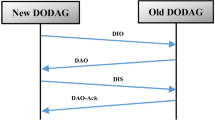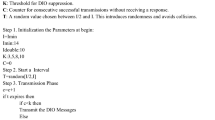Abstract
For the use in low-power and lossy networks (LLNs) under complex and harsh communication conditions, the routing protocol for LLNs (RPL) standardized by the Internet Engineering Task Force is specially designed. To improve the performance of LLNs, we propose a novel context-aware RPL algorithm based on a triangle module operator (CAR-TMO). A novel composite context-aware routing metric (CA-RM) is designed, which synchronously evaluates the residual energy index, buffer occupancy ratio of a node, expected transmission count (ETX), delay, and hop count from a candidate parent to the root. CA-RM considers the residual energy index and buffer occupancy ratio of the candidate parent and its preferred parent in a recursive manner to reduce the effect of upstream parents, since farther paths are considered. CA-RM comprehensively uses the sum, mean, and standard deviation values of ETX and delay of links in a path to ensure a better performance. Moreover, in CAR-TMO, the membership function of each routing metric is designed. Then, a comprehensive membership function is constructed based on a triangle module operator, the membership function of each routing metric, and a comprehensive context-aware objective function. A novel mechanism for calculating the node rank and the mechanisms for preferred parent selection are proposed. Finally, theoretical analysis and simulation results show that CAR-TMO outperforms several state-of-the-art RPL algorithms in terms of the packet delivery ratio and energy efficiency.
摘要
低功耗有损网络路由协议 (RPL) 由因特网工程任务组设计, 主要适用于通信条件复杂、 环境恶劣的低功耗有损网络. 为进一步提高低功耗有损网络性能, 本文提出一种基于三角模算子的情景感知RPL新算法 (CAR-TMO). 首先设计了一种新的情景感知复合路由度量 (CA-RM) ; CA-RM可综合评估候选父节点的剩余能量指数、 缓存占用率、 以及该候选父节点到根节点之间路径所需的期望传输数 (ETX)、 时延和跳数. CA-RM以递归方式评估了候选父节点及其偏好父节点的剩余能量指数和缓存占用率, 以降低上游父节点对偏好父节点选择的影响. CA-RM综合使用路径上各链路ETX和时延的和值、 均值和均方差值以进一步提高网络性能. 其次, 设计了上述各路由度量的隶属度函数. 然后, 基于三角模算子和各路由度量的隶属度函数构造综合隶属度函数和情景感知目标函数 (CA-OF). 此外, 提出新的计算节点秩值和偏好父节点选择机制. 最后, 理论分析和仿真结果均表明, CAR-TMO在分组投递成功率、 能效等方面均优于RPL及其相关改进算法.
Similar content being viewed by others
Explore related subjects
Discover the latest articles and news from researchers in related subjects, suggested using machine learning.References
Alishahi M, Moghaddam MHY, Pourreza HR, 2018. Multi-class routing protocol using virtualization and SDN-enabled architecture for smart grid. Peer-to-Peer Netw Appl, 11(3):380–396. https://doi.org/10.1007/s12083-016-0537-1
Al-Kashoash HAA, Al-Nidawi Y, Kemp AH, 2016. Congestion-aware RPL for 6L0WPAN networks. Proc Wireless Telecommunications Symp, p.1–6. https://doi.org/10.1109/WTS.2016.7482026
Araújo HDS, Filho RH, Rodrigues JJPC, et al., 2018. A proposal for IoT dynamic routes selection based on contextual information. Sensors, 18(2):353. https://doi.org/10.3390/s18020353
Bhandari KS, Hosen ASMS, Cho GH, 2018. CoAR: congestion-aware routing protocol for low power and lossy networks for IoT applications. Sensors, 18(11):3838. https://doi.org/10.3390/s18113838
Cao YN, Wu MQ, 2018. RPL based on triangle module operator for AMI networks. China Commun, 15(5):162–172. https://doi.org/10.1109/CC.2018.8387995
Ganesh DR, Patil KK, Suresh L, 2019. Q-FRPML: QoS-centric fault-resilient routing protocol for mobile-WSN based low power lossy networks. Wirel Pers Commun, 105(1):267–292. https://doi.org/10.1007/s11277-018-6112-8
Gao L, Zheng ZW, Huo MM, 2018. Improvement of RPL protocol algorithm for smart grid. Proc IEEE 18th Int Conf on Communication Technology, p.927–930. https://doi.org/10.1109/ICCT.2018.8600162
Gnawali O, Levis P, 2012. The minimum rank with hysteresis objective function. Proc Internet Engineering Task Force, RFC 6719.
Hassan A, Alshomrani S, Altalhi A, et al., 2016. Improved routing metrics for energy constrained interconnected devices in low-power and lossy networks. J Commun Netw, 18(3):327–332. https://doi.org/10.1109/JCN.2016.000048
Huynh TT, Lin CM, Le TL, et al., 2020. A new self-organizing fuzzy cerebellar model articulation controller for uncertain nonlinear systems using overlapped Gaussian membership functions. IEEE Trans Ind Electron, 67(11):9671–9682. https://doi.org/10.1109/TIE.2019.2952790
Karkazis P, Trakadas P, Leligou HC, et al., 2013. Evaluating routing metric composition approaches for QoS differentiation in low power and lossy networks. Wirel Netw, 19(6):1269–1284. https://doi.org/10.1007/s11276-012-0532-2
Kheaksong A, Srisomboon K, Prayote A, et al., 2018. Multi-criteria parent selection using cognitive radio for RPL in smart grid network. Wirel Commun Mob Comput, 2018: 9590576. https://doi.org/10.1155/2018/9590576
Kim HS, Kim H, Paek J, et al., 2017. Load balancing under heavy traffic in RPL routing protocol for low power and lossy networks. IEEE Trans Mob Comput, 16(4):964–979. https://doi.org/10.1109/TMC.2016.2585107
Lamaazi H, Benamar N, 2018. OF-EC: a novel energy consumption aware objective function for RPL based on fuzzy logic. J Netw Comput Appl, 117:42–58. https://doi.org/10.1016/j.jnca.2018.05.015
Memon RA, Li JP, Ahmed J, et al., 2020. Cloud-based vs. blockchain-based IoT: a comparative survey and way forward. Front Inform Technol Electron Eng, 21(4):563–586. https://doi.org/10.1631/FITEE.1800343
Monowar MM, Basheri M, 2020. Corrigendum to “on providing differentiated service exploiting multi-instance RPL for industrial low-power and lossy networks”. Wirel Commun Mob Comput, 2020:2896561. https://doi.org/10.1155/2020/2896561
Nassar J, Berthomé M, Dubrulle J, et al., 2018. Multiple instances QoS routing in RPL: application to smart grids. Sensors, 18(8):2472. https://doi.org/10.3390/s18082472
Nayak P, Devulapalli A, 2016. A fuzzy logic-based clustering algorithm for WSN to extend the network lifetime. IEEE Sens J, 16(1):137–144. https://doi.org/10.1109/JSEN.2015.2472970
Nikolic M, Selmic M, Macura D, et al., 2020. Bee colony optimization metaheuristic for fuzzy membership functions tuning. Exp Syst Appl, 158:113601. https://doi.org/10.1016/j.eswa.2020.113601
Pereira H, Moritz GL, Souza RD, et al., 2020. Increased network lifetime and load balancing based on network interface average power metric for RPL. IEEE Access, 8:48686–48696. https://doi.org/10.1109/ACCESS.2020.2979834
Sanmartin P, Rojas A, Fernandez L, et al., 2018. Sigma routing metric for RPL protocol. Sensors, 18(4):1277. https://doi.org/10.3390/s18041277
Seyfollahi A, Ghaffari A, 2020. A lightweight load balancing and route minimizing solution for routing protocol for low-power and lossy networks. Comput Netw, 179: 107368. https://doi.org/10.1016/j.comnet.2020.107368
Solapure SS, Kenchannavar HH, 2020. Design and analysis of RPL objective functions using variant routing metrics for IoT applications. Wirel Netw, 26(6):4637–4656. https://doi.org/10.1007/s11276-020-02348-6
Taghizadeh S, Bobarshad H, Elbiaze H, 2018. CLRPL: context-aware and load balancing RPL for IoT networks under heavy and highly dynamic load. IEEE Access, 6:23277–23291. https://doi.org/10.1109/ACCESS.2018.2817128
Thubert P, 2012. Objective function zero for the routing protocol for low-power and lossy networks (RPL). Proc Internet Engineering Task Force, RFC 6552.
Velivasaki THN, Karkazis P, Zahariadis TV, et al., 2014. Trust-aware and link-reliable routing metric composition for wireless sensor networks. Trans Emerg Telecommun Technol, 25(5):539–554. https://doi.org/10.1002/ett.2592
Wadhaj I, Ghaleb B, Thomson C, et al., 2020. Mitigation mechanisms against the DAO attack on the routing protocol for low power and lossy networks (RPL). IEEE Access, 8:43665–43675. https://doi.org/10.1109/ACCESS.2020.2977476
Winter T, Thubert P, Brandt A, et al., 2012. RPL: IPv6 routing protocol for low-power and lossy networks. Proc Internet Engineering Task Force, RFC 6550.
Zahariadis T, Trakadas P, 2012. Design guidelines for routing metrics composition in LLN. Internet Engineering Task Force, Draft. http://www.ietf.org/1id-abstracts.html
Author information
Authors and Affiliations
Contributions
Yanan CAO designed the research. Yanan CAO and Hao YUAN processed the data. Yanan CAO drafted the paper. Hao YUAN helped organize the paper. Yanan CAO and Hao YUAN revised and finalized the paper.
Corresponding author
Ethics declarations
Yanan CAO and Hao YUAN declare that they have no conflict of interest.
Additional information
Project supported by the Doctoral Research Project of Tianjin Normal University, China (No. 52XB2101)
Rights and permissions
About this article
Cite this article
Cao, Y., Yuan, H. A novel context-aware RPL algorithm based on a triangle module operator. Front Inform Technol Electron Eng 22, 1583–1597 (2021). https://doi.org/10.1631/FITEE.2000658
Received:
Accepted:
Published:
Issue Date:
DOI: https://doi.org/10.1631/FITEE.2000658
Key words
- Triangle module operator
- Membership function
- Context-aware
- Routing protocol for low-power and lossy networks (RPL)
- Routing metrics




